Discover 50 hidden attractions, cool sights, and unusual things to do in Russia. Don't miss out on these must-see attractions: Peterhof Palace (Saint Petersburg), Winter Palace (Saint Petersburg) or Hermitage Museum (Saint Petersburg).
Below, you can find the list of the most amazing places you should visit in Russia.
Table of Contents
Peterhof Palace, Saint Petersburg

Also known as: Петергоф
Museum in Saint Petersburg, Russia. The Peterhof Palace, is a series of palaces and gardens located in Petergof, Saint Petersburg, Russia, commissioned by Peter the Great as a direct response to the Palace of Versailles by Louis XIV of France. Originally intending it in 1709 for country habitation, Peter the Great sought to expand the property as a result of his visit to the French royal court in 1717, inspiring the nickname of "The Russian Versailles". The architect between 1714 and 1728 was Domenico Trezzini, and the style he employed became the foundation for the Petrine Baroque style favored throughout Saint Petersburg. Also in 1714, Jean-Baptiste Alexandre Le Blond, likely chosen due to his previous collaborations with Versailles landscaper André Le Nôtre, designed the gardens. Francesco Bartolomeo Rastrelli completed an expansion from 1747 to 1756 for Elizabeth of Russia. The palace-ensemble along with the city center is recognized as a UNESCO World Heritage Site.[1]
Address: Razvodnaya Ulitsa, 198510 Petergof
Winter Palace, Saint Petersburg
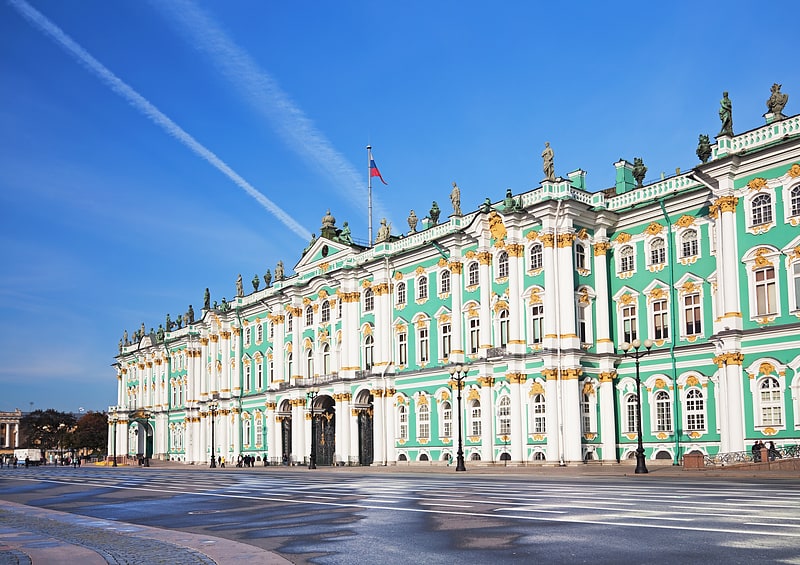
Also known as: Зимний дворец
Former residence of Russian emperors. The Winter Palace is a palace in Saint Petersburg that served as the official residence of the Russian Emperor from 1732 to 1917. The palace and its precincts now house the Hermitage Museum. Situated between Palace Embankment and Palace Square, adjacent to the site of Peter the Great's original Winter Palace, the present and fourth Winter Palace was built and altered almost continuously between the late 1730s and 1837, when it was severely damaged by fire and immediately rebuilt. The storming of the palace in 1917, as depicted in Soviet art and in Sergei Eisenstein's 1928 film October, became an iconic symbol of the Russian Revolution.
The emperors constructed their palaces on a monumental scale that aimed to reflect the might and power of Imperial Russia. From the palace, the tsars ruled over 22,800,000 square kilometers (8,800,000 sq mi) (almost 1/6 of the Earth's landmass) and 125 million subjects by the end of the 19th century. Several architects participated in designing the Winter Palace—most notably the Italian Bartolomeo Rastrelli (1700–1771)—in what became known as the Elizabethan Baroque style. The green-and-white palace has the overall shape of an elongated rectangle, and its principal façade is 215 metres (705 ft) long and 30 m (98 ft) high. The Winter Palace has been calculated to contain 1,886 doors, 1,945 windows, 1,500 rooms and 117 staircases. Following a serious fire, the palace's rebuilding of 1837 left the exterior unchanged, but large parts of the interior were redesigned in a variety of tastes and styles, leading the palace to be described as a "19th-century palace inspired by a model in Rococo style".
In 1905 the Bloody Sunday massacre occurred when demonstrators marched toward the Winter Palace, but by this time the Imperial Family had chosen to live in the more secure and secluded Alexander Palace at Tsarskoe Selo, and returned to the Winter Palace only for formal and state occasions. Following the February Revolution of 1917, the palace operated for a short time as the seat of the Russian Provisional Government, ultimately led by Alexander Kerensky. Later that same year a detachment of Red Guard soldiers and sailors stormed the palace—a defining moment in the birth of the Soviet state.[2]
Address: Palace Embankment, 32, 190000 Sankt-Peterburg (Центральный район)
Hermitage Museum, Saint Petersburg

Also known as: Эрмитаж
Art and culture museum founded in 1764. The State Hermitage Museum is a museum of art and culture in Saint Petersburg, Russia. It is the largest art museum in the world by gallery space. It was founded in 1764 when Empress Catherine the Great acquired an impressive collection of paintings from the Berlin merchant Johann Ernst Gotzkowsky. The museum celebrates the anniversary of its founding each year on 7 December, Saint Catherine's Day. It has been open to the public since 1852. In 2021 it ranked 6th in the List of most visited art museums in the world, with 1,649,443 visitors.
Its collections, of which only a small part is on permanent display, comprise over three million items. The collections occupy a large complex of six historic buildings along Palace Embankment, including the Winter Palace, a former residence of Russian emperors. Apart from them, the Menshikov Palace, Museum of Porcelain, Storage Facility at Staraya Derevnya, and the eastern wing of the General Staff Building are also part of the museum. The museum has several exhibition centers abroad. The Hermitage is a federal state property. Since July 1992, the director of the museum has been Mikhail Piotrovsky.
Of the six buildings in the main museum complex, five—namely the Winter Palace, Small Hermitage, Old Hermitage, New Hermitage, and Hermitage Theatre—are all open to the public. The entrance ticket for foreign tourists costs more than the fee paid by citizens of Russia and Belarus. However, entrance is free of charge the third Thursday of every month for all visitors, and free daily for students and children. The museum is closed on Mondays. The entrance for individual visitors is located in the Winter Palace, accessible from the Courtyard.[3]
Address: Palace Square, 2, 190000 Sankt-Peterburg (Центральный район)
Red Square, Moscow
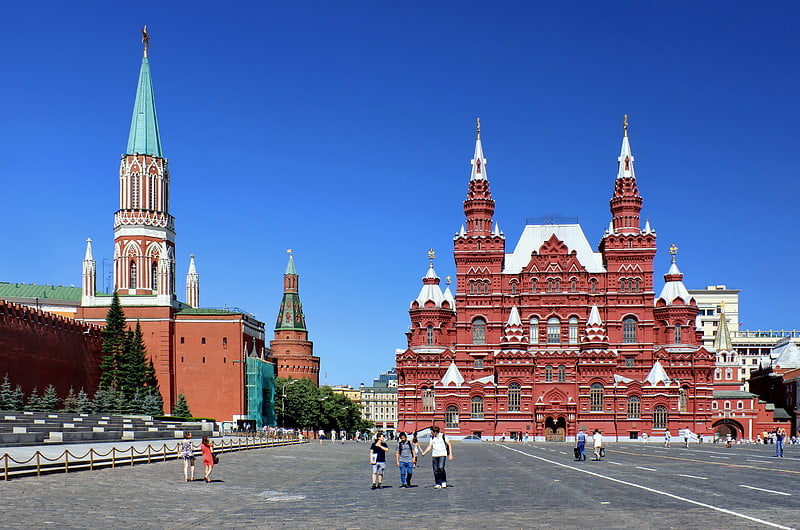
Also known as: Красная площадь
Landmark square and site of cathedral. Red Square is one of the oldest and largest squares in Moscow, the capital of Russia. Owing to its historical significance and the adjacent historical buildings, it is regarded as one of the most famous squares in Europe and the world. It is located in Moscow's historic centre, in the eastern walls of the Kremlin. It is the city landmark of Moscow, with iconic buildings such as Saint Basil's Cathedral, Lenin's Mausoleum and the GUM. In addition, it has been a UNESCO World Heritage Site since 1990.[4]
Novodevichy Convent, Moscow
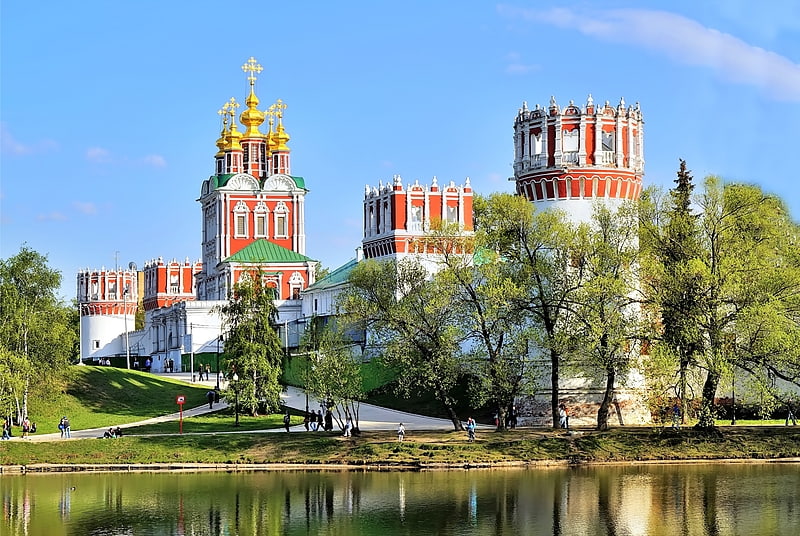
Also known as: Новодевичий монастырь
Landmark 16th-century religious complex. Novodevichy Convent, also known as Bogoroditse-Smolensky Monastery, is probably the best-known cloister of Moscow. Its name, sometimes translated as the New Maidens' Monastery, was devised to differ from the Old Maidens' Monastery within the Moscow Kremlin. Unlike other Moscow cloisters, it has remained virtually intact since the 17th century. In 2004, it was proclaimed a UNESCO World Heritage Site.[5]
Address: Novodevichy Passage, 1, 119435 Moskva (Центральный административный ок)
Tretyakov Gallery, Moscow
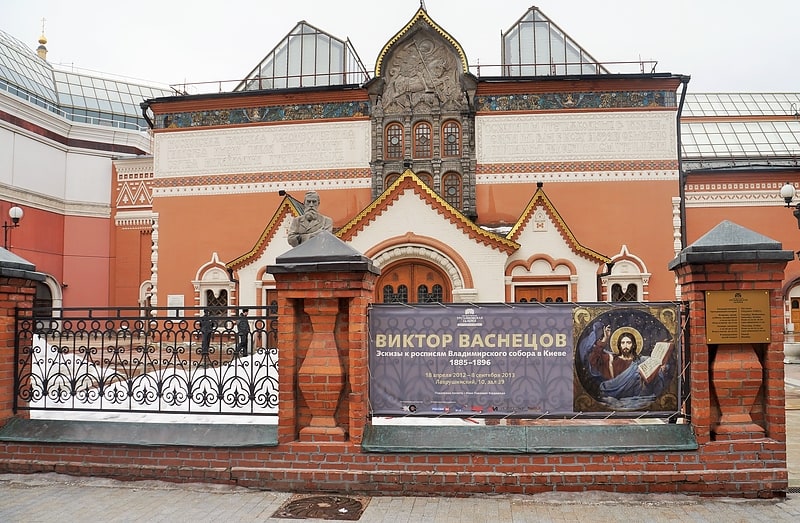
Also known as: Государственная Третьяковская галерея
Collection of 21st-century Russian art. The State Tretyakov Gallery is an art gallery in Moscow, Russia, the foremost depository of Russian fine art in the world.
The gallery's history starts in 1856 when the Moscow merchant Pavel Mikhailovich Tretyakov acquired works by Russian artists of his day with the aim of creating a collection, which might later grow into a museum of national art. In 1892, Tretyakov presented his already famous collection of approximately 2,000 works (1,362 paintings, 526 drawings, and 9 sculptures) to the Russian nation. The museum attracted 894,374 (visitors in 2020 (down 68 percent from 2019), due to the COVID-19 pandemic. It was 13th on the list of most-visited art museums in the world in 2020.
The façade of the gallery building was designed by the painter Viktor Vasnetsov in a peculiar Russian fairy-tale style. It was built in 1902–04 to the south from the Moscow Kremlin. During the 20th century, the gallery expanded to several neighboring buildings, including the 17th-century church of St. Nicholas in Tolmachi.
The collection contains more than 130,000 exhibits, ranging from Theotokos of Vladimir and Andrei Rublev's Trinity to the monumental Composition VII by Wassily Kandinsky and the Black Square by Kazimir Malevich.
In 1977 the Gallery kept a significant part of the George Costakis collection.
In May 2012, the Tretyakov Art Gallery played host to the prestigious FIDE World Chess Championship between Viswanathan Anand and Boris Gelfand as the organizers felt the event would promote both chess and art at the same time.[6]
Address: Lavrushinsky Ln, 10, 119017 Moskva (Центральный административный ок)
Kazan Kremlin, Kazan
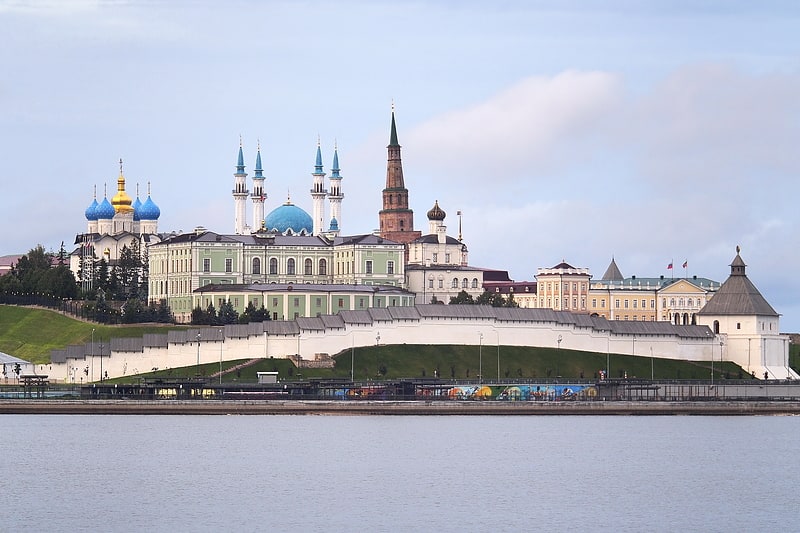
Also known as: Казанский кремль
Hilltop palace and museum complex. The Kazan Kremlin is the chief historic citadel of Russia, situated in the city of Kazan. It was built at the behest of Ivan the Terrible on the ruins of the former castle of Kazan khans. It was declared a World Heritage Site in 2000.[7]
Dormition Cathedral, Vladimir

Also known as: Успенский собор
Cathedral in Vladimir, Russia. The Dormition Cathedral in Vladimir was a mother church of Medieval Russia in the 13th and 14th centuries. It is part of a World Heritage Site, the White Monuments of Vladimir and Suzdal.
The cathedral was commissioned by Andrew the Pious in his capital, Vladimir, and dedicated to the Dormition of the Theotokos (Virgin Mary), whom he promoted as the patron saint of his lands. Originally erected in 1158 to 1160, the cathedral, with six pillars and five domes, was expanded in 1185 to 1189 to reflect the augmented prestige of Vladimir. At 1178 m², it remained the largest Russian church for several hundred years.
Andrew the Pious, Vsevolod the Big Nest and other rulers of Vladimir-Suzdal were interred in the crypt of this church. Unlike many other churches, the cathedral survived the great devastation and fire of Vladimir in 1239, when the Mongol hordes of Batu Khan took hold of the capital.
The exterior walls of the church are covered with elaborate carvings. The interior was painted in the 12th century and then repainted by Andrei Rublev and Daniil Chernyi in 1408. The Dormition Cathedral served as a model for Aristotele Fioravanti, when he designed the eponymous cathedral in the Moscow Kremlin in 1475 to 1479. A lofty belltower, combining genuine Russian, Gothic and Neoclassical influences, was erected nearby in 1810.[8]
Address: Bolshaya Moskovskaya St, 56, 600000 Vladimir
Suzdal Kremlin, Suzdal
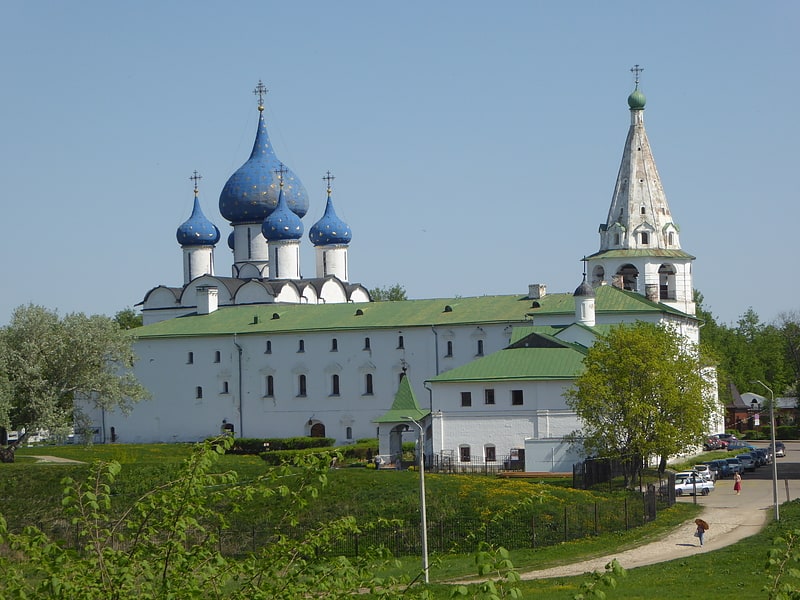
Also known as: Суздальский кремль
Striking white-stone medieval citadel. The Suzdal Kremlin is the oldest part of the Russian city of Suzdal, dating from the 10th century. Like other Russian Kremlins, it was originally a fortress or citadel and was the religious and administrative center of the city. It is most notably the site of the Cathedral of the Nativity.
Together with several structures in the neighboring city of Vladimir, it was named a UNESCO World Heritage Site in 1992.[9]
Address: Kremlovskaya Ulitsa, 27, 601293 Suzdal
Amber Room, Pushkin
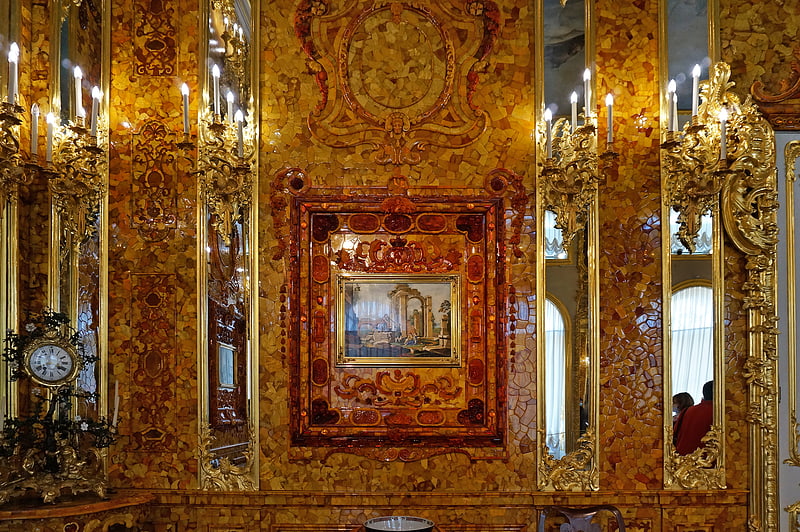
Also known as: Янтарная комната
Reconstruction of the historic mosaics. The Amber Room was a chamber decorated in amber panels backed with gold leaf and mirrors, located in the Catherine Palace of Tsarskoye Selo near Saint Petersburg.
Constructed in the 18th century in Prussia, the room was dismantled and eventually disappeared during World War II. Before its loss, it was considered an "Eighth Wonder of the World". A reconstruction was made, starting in 1979 and completed and installed in the Catherine Palace in 2003.
The Amber Room was intended in 1701 for the Charlottenburg Palace, in Berlin, Prussia, but was eventually installed at the Berlin City Palace. It was designed by German baroque sculptor Andreas Schlüter and Danish amber craftsman Gottfried Wolfram. Schlüter and Wolfram worked on the room until 1707, when work was continued by amber masters Gottfried Turau and Ernst Schacht from Danzig (Gdańsk).
It remained in Berlin until 1716, when it was given by the Prussian King Frederick William I to his ally Tsar Peter the Great of the Russian Empire. In Russia, the room was installed in the Catherine Palace. After expansion and several renovations, it covered more than 55 square metres (590 sq ft) and contained over 6 tonnes (13,000 lb) of amber.
The Amber Room was looted during World War II by the Army Group North of Nazi Germany, and taken to Königsberg for reconstruction and display. Some time in early 1944, with Allied forces closing in on Germany, the room was disassembled and crated for storage in the Castle basement. Konigsberg was destroyed by allied bombers in August 1944 and documentation of the room location ends there. Its eventual fate and current whereabouts, if it survives, remain a mystery. In 1979 the decision was taken to create a reconstructed Amber Room at the Catherine Palace in Pushkin. After decades of work by Russian craftsmen and donations from Germany, it was completed and inaugurated in 2003.[10]
Address: Екатерининский дворец, Pushkin
Alexander Palace, Pushkin
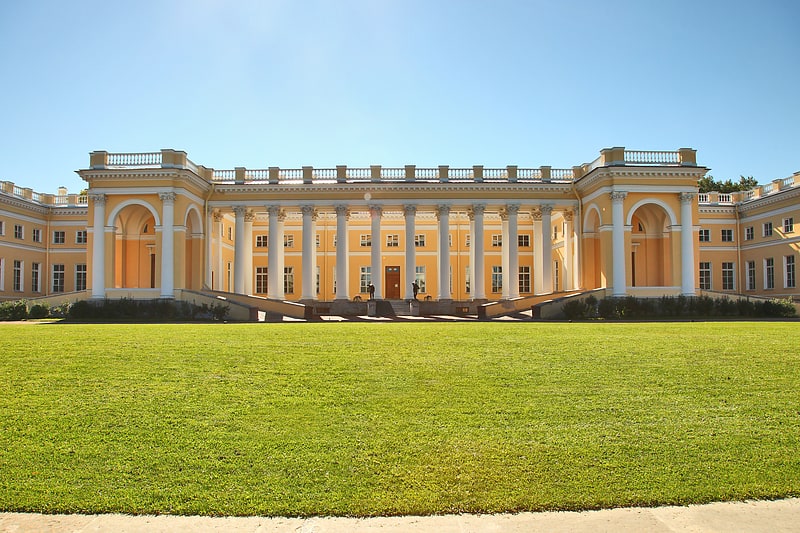
Also known as: Александровский дворец
Imperial residence in Saint Petersburg, Russia. Alexander Palace is a former imperial residence near the town of Tsarskoye Selo in Russia, on a plateau about 30 miles south of Saint Petersburg. The Palace was commissioned by Empress/Tsarina Catherine II in 1792.
Due to the privacy it offered, when officially resident in St Petersburg, Alexander Palace was the preferred residence of the last Russian Emperor, Nicholas II and his family. Its safety and seclusion compared favourably to the Winter Palace during the years immediately prior to the Russian Revolution. In 1917, the palace became the family’s initial place of imprisonment after the first of two Russian Revolutions in February which overthrew the House of Romanov during World War I. Alexander Palace is situated in Alexander Park, not far from Catherine Park and the larger, more elaborate Catherine Palace. After undergoing years of renovation, Alexander Palace opened in Summer 2021 as a state museum housing relics of the former imperial dynasty.[11]
Address: Sadovay str, 2, 196601 Pushkin
Yuriev Monastery, Novgorod
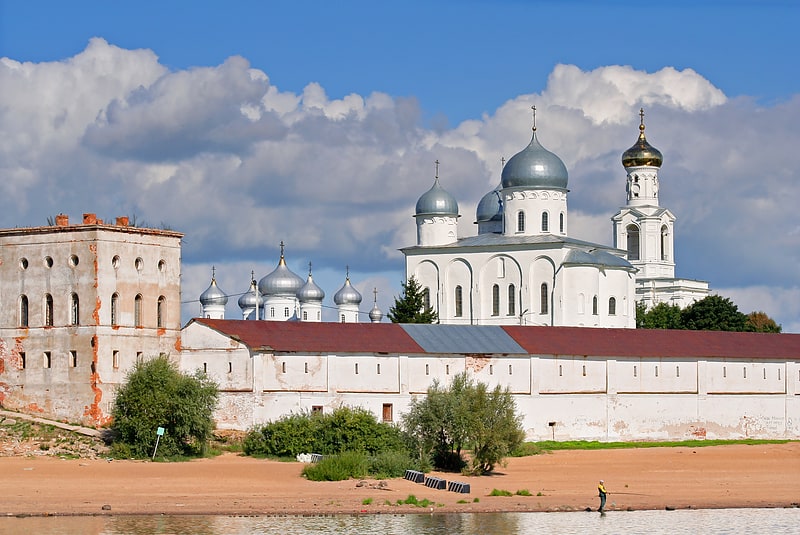
Also known as: Юрьев монастырь
Silver-domed medieval Orthodox monastery. The St. George's Monastery is usually cited as Russia's oldest monastery. It stands in 5 kilometers south of Novgorod on the left bank of the Volkhov River near where it flows out of Lake Ilmen. The monastery used to be the most important in the medieval Novgorod Republic. It is part of the World Heritage Site named Historic Monuments of Novgorod and Surroundings.[12]
Address: Yuryevskoye Hwy., 10, 173007 Veliky Novgorod
Millennium of Russia, Novgorod
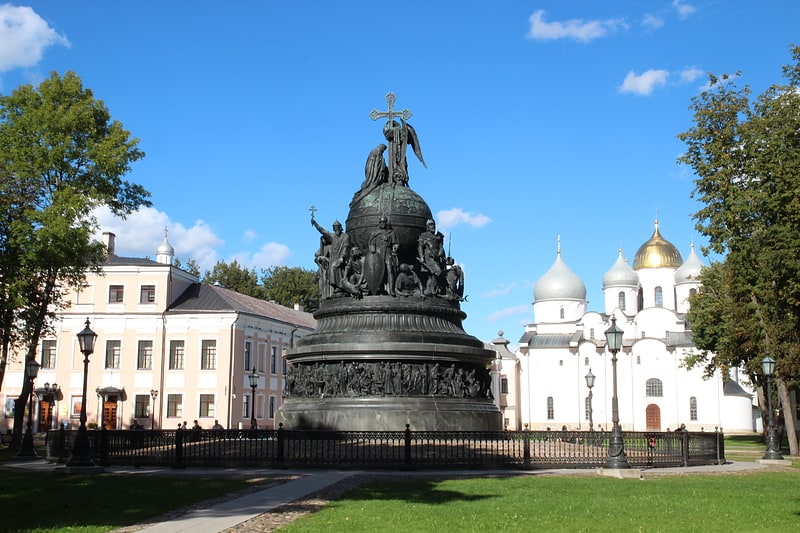
Also known as: Тысячелетие России
Large bronze monument from 1862. The Millennium of Russia is a bronze monument in the Novgorod Kremlin. It was erected in 1862 to celebrate the millennium of Rurik's arrival to Novgorod, an event traditionally taken as a starting point of the history of Russian statehood.[13]
Address: Novrogod Kremlin, Novgorod
Kaliningrad Amber Museum, Kaliningrad

Also known as: Музей янтаря
Amber museum in 19th-century fort. The Kaliningrad Regional Amber Museum is a museum located in the Russian city of Kaliningrad devoted to housing and displaying amber artworks. It is located in the city center, on the shore of Lake Verkhneye. Construction on the museum began in 1972.
The museum opened in 1979 and houses about 14,000 individual pieces. The museum occupies part of a reconstructed fortification, originally built by Karl Friedrich Emil zu Dohna-Schlobitten in the Napoleonic wars.
Among the exhibits are the world's second-largest piece of amber and a 4-foot-tall (1.2 m) vase named The Abundance, as well as a collection of over 3,000 amber inclusions. One of the most famous organic inclusions is a small lizard.[14]
Address: Ploshchad' Marshala Vasilevskogo, 1, 236035 Kaliningrad
Kaliningrad Zoo, Kaliningrad
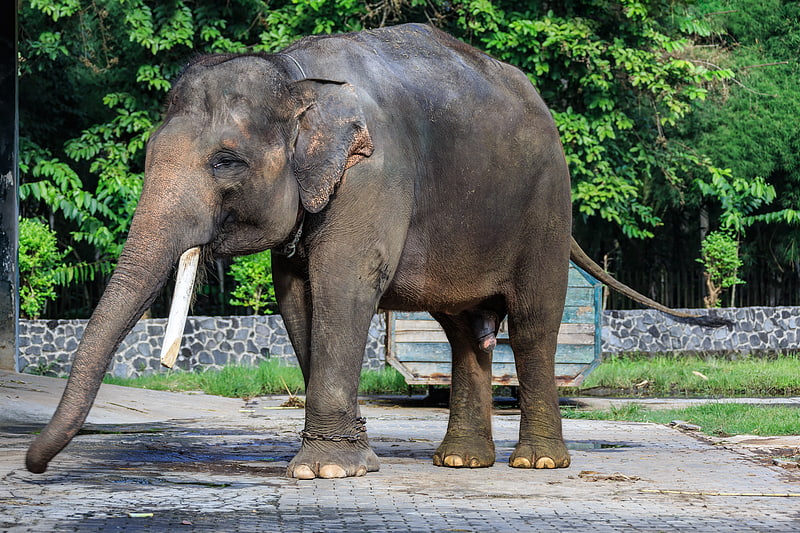
Also known as: Калининградский зоопарк
Historic zoo with thousands of species. The Kaliningrad Zoo was founded in 1896 as the Königsberger Tiergarten in the German town of Königsberg, which in 1945 became part of Russia and was renamed Kaliningrad. Thus, the zoo is one of the oldest zoological gardens in Russia, and one of the largest. Its collection, which extends over 16.5 ha, comprises 286 species with a total of 2130 individual animals.
The Kaliningrad zoo is also an arboretum. Sights include not only animals, but also rare plants like a relict ginkgo tree which was coeval with the dinosaurs.
The zoo also has animal sculptures, including a stone statue of an orangutan. The entrance is decorated by a animals group sculpture compositions. The grounds include pre-war buildings and a fountain.[15]
Address: Prospekt Mira, 26, 236022 Kaliningrad
Monastery of Saint Euthymius, Suzdal
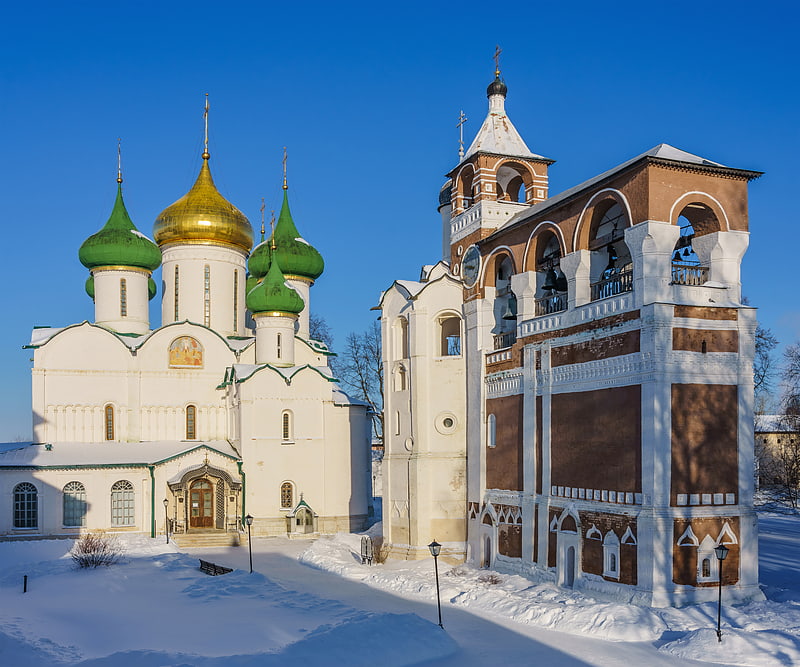
Also known as: Спасо-Евфимиев монастырь
Monastery in Suzdal, Russia. The Saviour Monastery of St. Euthymius is a monastery in Suzdal, Russia, founded in 1352.[16]
Address: Lenina St., 146, 601293 Suzdal
Catherine Park, Pushkin
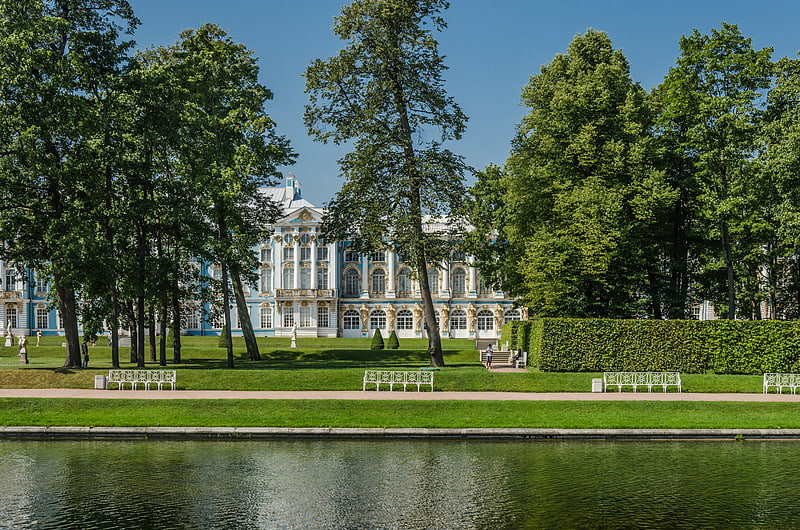
Also known as: Екатерининский парк
Park in Saint Petersburg, Russia. The Catherine Park is the large landscaped area to the south of the Catherine Palace, located in the town of Tsarskoye Selo, 25 km south-east of St. Petersburg, Russia.
The park has two parts: a formal 18th century Dutch-style garden and a natural English garden.[17]
Address: Garden St, 7, 196601 Pushkin
Königsberg Cathedral, Kaliningrad
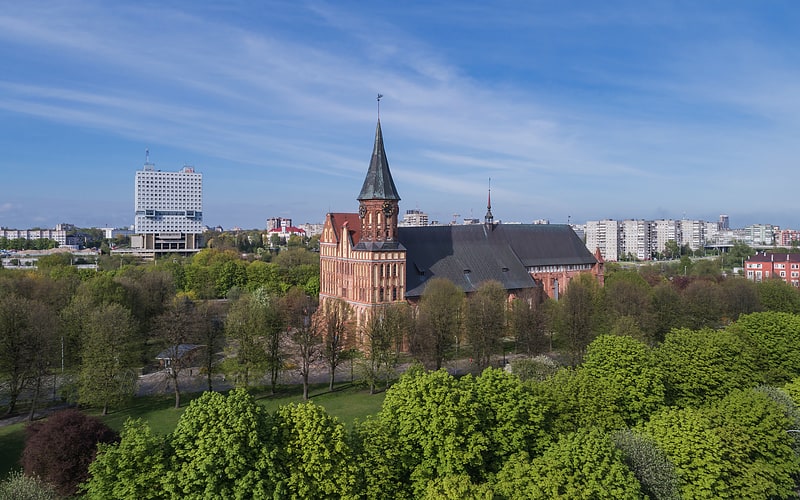
Also known as: Кафедральный собор в Калининграде
Gothic edifice with Immanuel Kant's tomb. Königsberg Cathedral is a Brick Gothic-style monument in Kaliningrad, Russia, located on Kneiphof island in the Pregel river. It is the most significant preserved building of the former City of Königsberg, which was largely destroyed in World War II.
Dedicated to Virgin Mary and St Adalbert, it was built as the see of the Prince-Bishops of Samland in the 14th century. Upon the establishment of the secular Duchy of Prussia, it became the Lutheran Albertina University church in 1544. The spire and roof of the cathedral burnt down after two RAF bombing raids in late August 1944; reconstruction started in 1992, after the dissolution of the Soviet Union.[18]
Address: Kanta St, 1, 236006 Kaliningrad
Cathedral of St. Demetrius, Vladimir
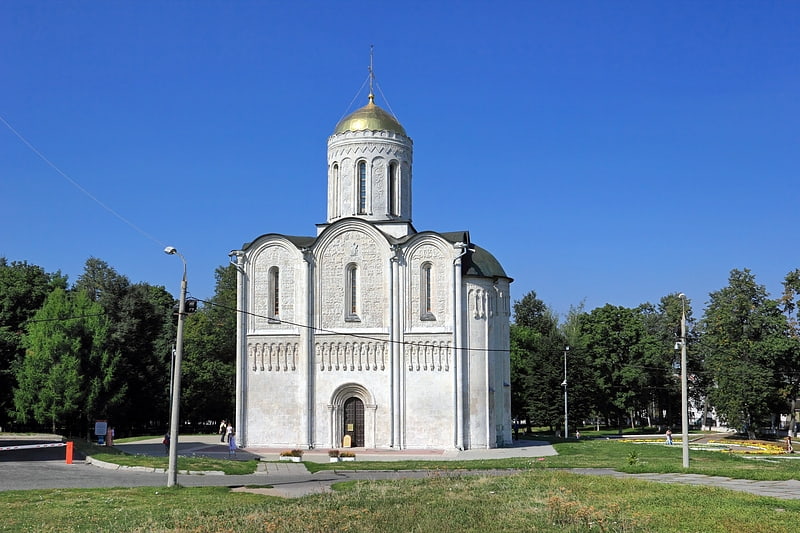
Also known as: Дмитриевский собор
Cathedral in Vladimir, Russia. The Cathedral of Saint Demetrius is a cathedral in the ancient Russian city of Vladimir. It was finished in 1197 during the reign of the Grand Prince Vsevolod the Big Nest of Vladimir-Suzdal to the honour of Saint Demetrius of Thessaloniki. Being an important component of the White Monuments of Vladimir and Suzdal, the cathedral belongs to the World Heritage of UNESCO. Currently, the cathedral is a part of the Vladimir-Suzdal open-air museum.[19]
Address: Bolshaya Moskovskaya St, 60, 600000 Vladimir
Qolşärif Mosque, Kazan

Also known as: Кул-Шариф
Blue-domed mosque on Kremlin site. The Kul Sharif Mosque located in Kazan Kremlin, was reputed to be – at the time of its construction – one of the largest mosques in Russia, and in Europe outside of Istanbul.[20]
Address: Ulitsa Sheynkmana, 420014 Kazan
Cathedral of St. Sophia, Novgorod
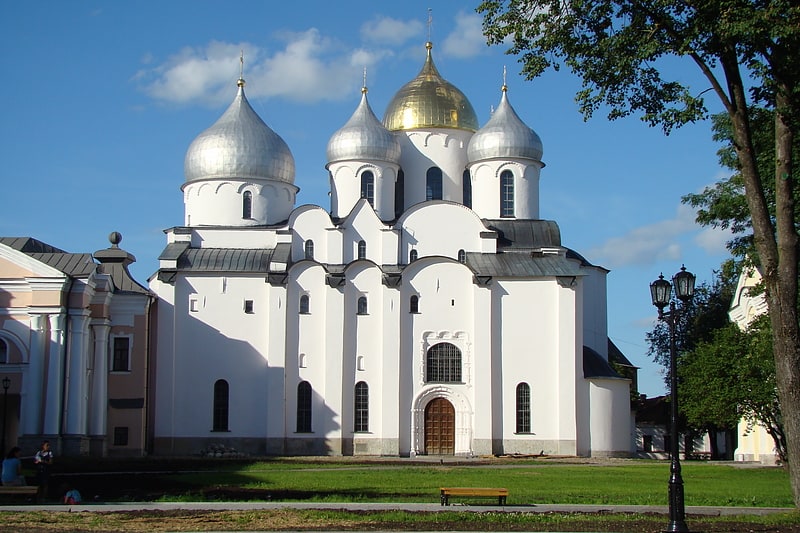
Also known as: Софийский собор
11th-century church with icons and mosaics. The Cathedral of Holy Wisdom in Veliky Novgorod is the cathedral church of the Metropolitan of Novgorod and the mother church of the Novgorodian Eparchy.[21]
Address: Новгородский Кремль, 173007 Великий Новгород
Novosibirsk Zoo, Novosibirsk

Also known as: Новосибирский зоопарк
Zoo in Novosibirsk, Russia. The Novosibirsk Zoo named after Rostislav Alexandrovich Shilo is a scientific institution as well as a popular tourist attraction. The zoo has around 11,000 animals representing 738 species and is an active participant in thirty-two different captive breeding programmes for endangered species. On average, over 1,500,000 people visit the zoo each year.[22]
Address: ул. Нарымская, Novosibirsk
Arseniev's Museum, Vladivostok
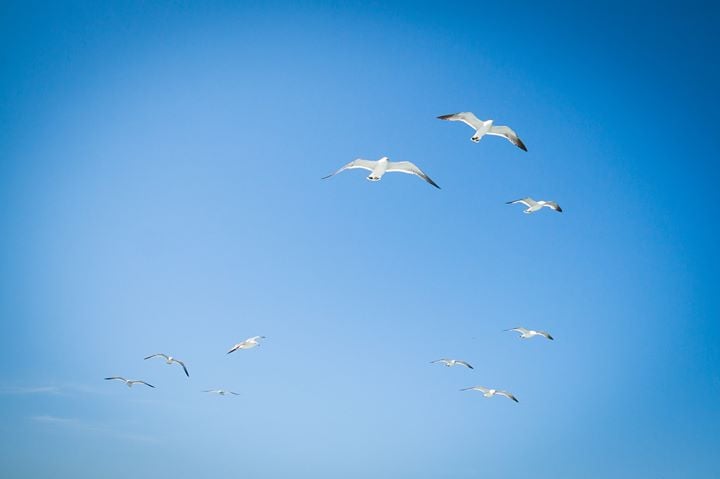
The Vladimir K. Arseniev Museum of Far East History is a museum named after the explorer, Vladimir Arseniev, in the city of Vladivostok in the Russian Far East. The museum's collections focus on the history of Vladivostok and the surrounding area in Primorsky Krai. The Vladimir K. Arseniev Museum of Far East History also manages the museum facilities at Vladivostok Fortress.[23]
Address: Svetlanskaya St., 20, 690091 Vladivostok
Orthodox cathedral of the Ascension of Christ, Novosibirsk
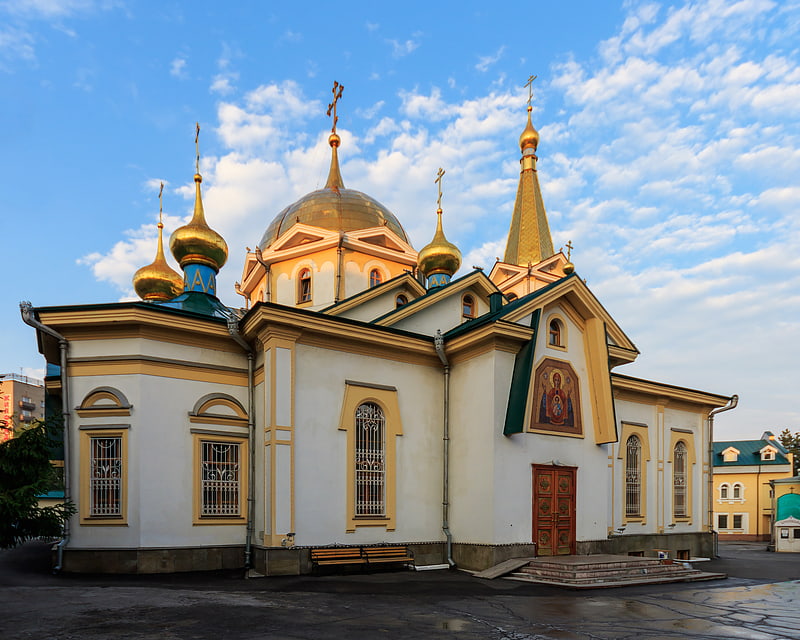
Russian orthodox church in Novosibirsk, Russia. The Orthodox cathedral of the Ascension of Christ is a Russian Orthodox church in Zheleznodorozhny City District of Novosibirsk, Russia.[24]
Church of the Protection of the Theotokos, Novosibirsk
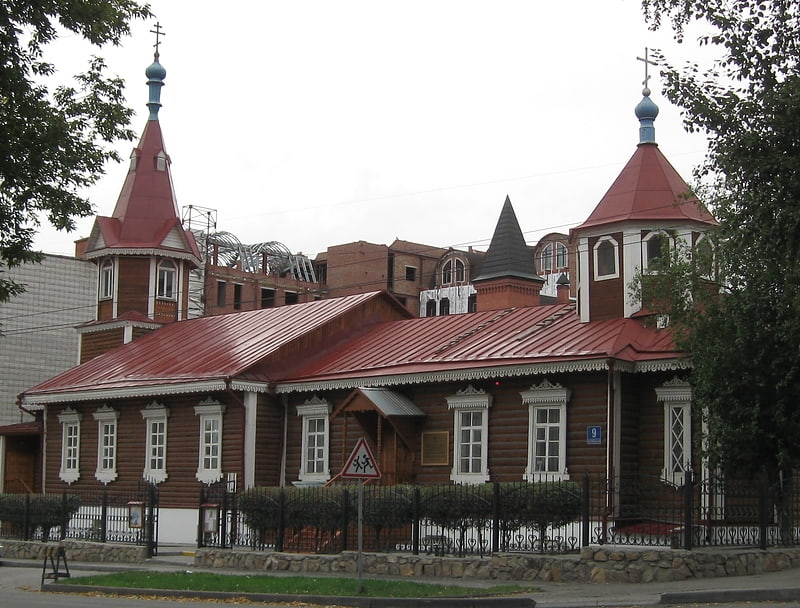
Church of the Protection of the Theotokos is a Russian Orthodox church in Zheleznodorozhny City District of Novosibirsk, Russia. It was built in 1901[25]
Address: 9 Октябрьская улица, Novosibirsk
Alferaki Palace, Taganrog
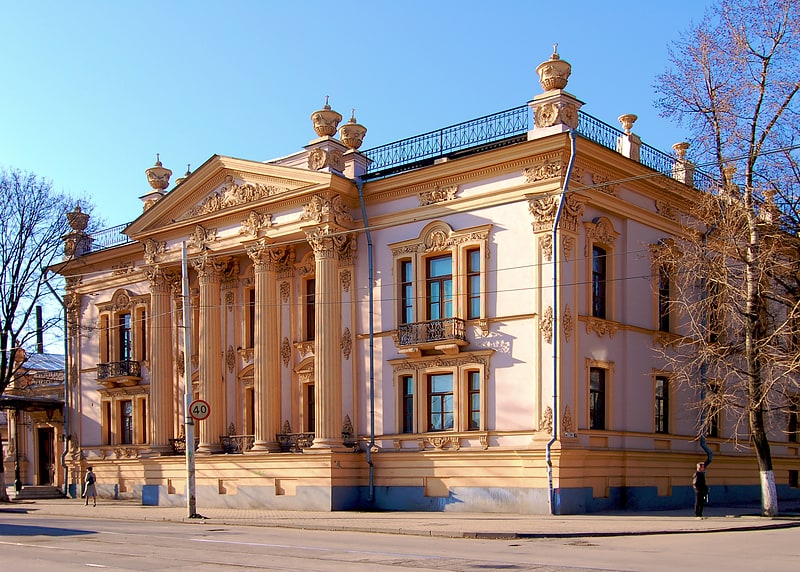
Also known as: Дворец Алфераки
Museum in Taganrog, Russia. Alferaki Palace is a museum in Taganrog, Russia, originally the home of the wealthy merchant Nikolay Alferaki. It was built in 1848 by the architect Andrei Stackenschneider on Frunze Street, in downtown Taganrog.
The building is decorated with a portal featuring four Corinthian columns and stucco moulding in the baroque style. A suite of rooms was created inside, along with a spacious music hall with a ceiling-painting.[26]
Address: Ulitsa Frunze, 41, 347900 Taganrog
The Kremlin, Nizhny Novgorod
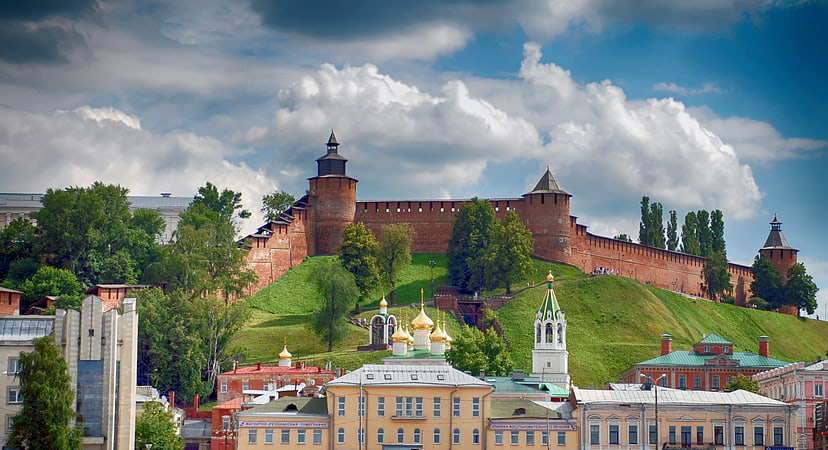
Also known as: Нижегородский кремль
Medieval fortress, now home to museums. The Nizhny Novgorod Kremlin is a fortress in Nizhny Novgorod, the historic city center.[27]
Address: Minina and Pozharskogo square, 603005 Nizhny Novgorod
Vyborg Castle, Vyborg

Also known as: Выборгский замок
Waterfront 13th-century Swedish fortress. Vyborg Castle is a Swedish-built medieval fortress around which the town of Vyborg evolved. The castle became the stronghold of the Swedish realm in the Karelian region. Throughout the centuries, it was the first defence of the kingdom against Russians. Its military and strategic status in the late Middle Ages was second only to the fortified capital Stockholm. Currently it serves as the site of Vyborg Regional Museum.[28]
Address: Замковый остров, 188800 Выборг
Gatchina Palace, Gatchina
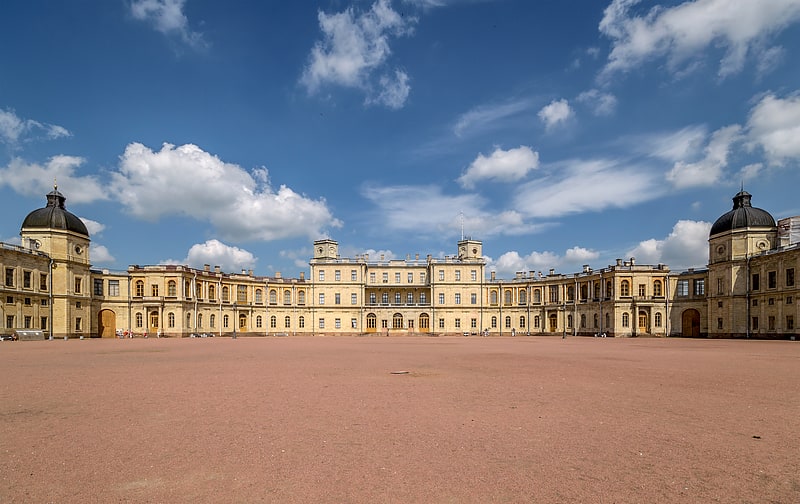
Also known as: Большой Гатчинский дворец
Fine arts museum in 18th-century palace. The Great Gatchina Palace is a palace in Gatchina, Leningrad Oblast, Russia. It was built from 1766 to 1781 by Antonio Rinaldi for Count Grigori Grigoryevich Orlov, who was a favourite of Catherine the Great, in Gatchina, a suburb of the royal capital Saint Petersburg. The Gatchina Palace combines classical architecture and themes of a medieval castle with ornate interiors typical of Russian classicism, located on a hill in central Gatchina next to Lake Serebryany. The Gatchina Palace became one of the favourite residences of the Russian Imperial Family, and during the 19th century was an important site of Russian politics. Since the February Revolution in 1917 it has been a museum and public park, and received UNESCO World Heritage Site status in 1990.[29]
Address: Krasnoarmeyskiy Prospekt, 1, 188307 Gatchina
Golden Gate, Vladimir
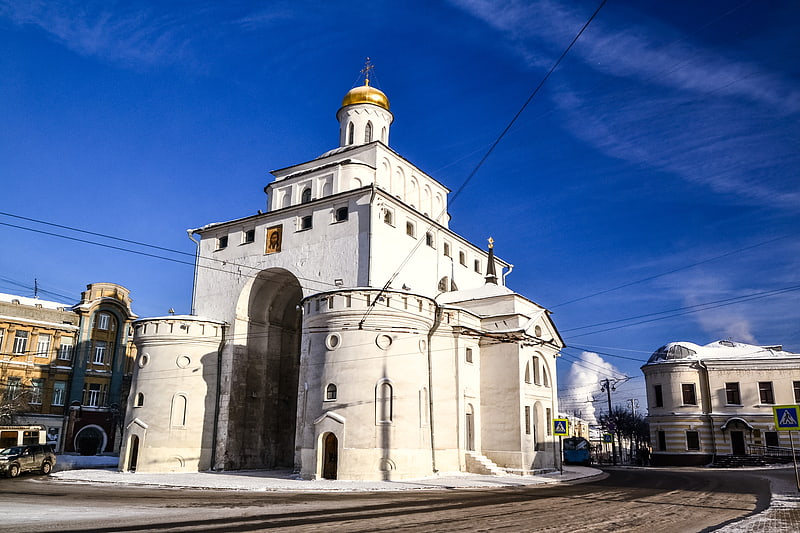
Also known as: Золотые ворота
Museum in Vladimir, Russia. The Golden Gate of Vladimir, constructed between 1158 and 1164, is the only preserved ancient Russian city gate. A museum inside focuses on the history of the Mongol invasion of Russia in the 13th century.
Golden Gates existed in the holiest cities of Eastern Orthodoxy: Jerusalem, Constantinople, and Kiev. On making Vladimir his capital, Andrew the Pious aspired to emulate these structures, commissioning a lofty tower over the city's main gate to be erected in limestone and lined with golden plaques. According to ancient Russian chronicles, the masons were invited from Friedrich Barbarossa. The main arch used to stand 15 meters tall. The structure was topped with a barbican church dedicated to the Deposition of the Virgin's Robe and symbolizing the Theotokos's protection of Andrew's capital.
The gate survived the Mongol destruction of Vladimir in 1237. By the late 18th century, however, the structure had so deteriorated that Catherine the Great was afraid to pass through the arch for fear of its tumbling down. In 1779, she ordered detailed measurements and drawings of the monument to be executed. In 1795, after many discussions, the vaults and barbican church were demolished. Two flanking round towers were constructed in order to reinforce the structure, and artisans then reconstructed the barbican, following the drawings made in 1779.
The site became a UNESCO World Heritage site in 1992.[30]
Address: Bolshaya Moskovskaya, 1A, 600000 Vladimir
Birth house of Anton Chekhov, Taganrog
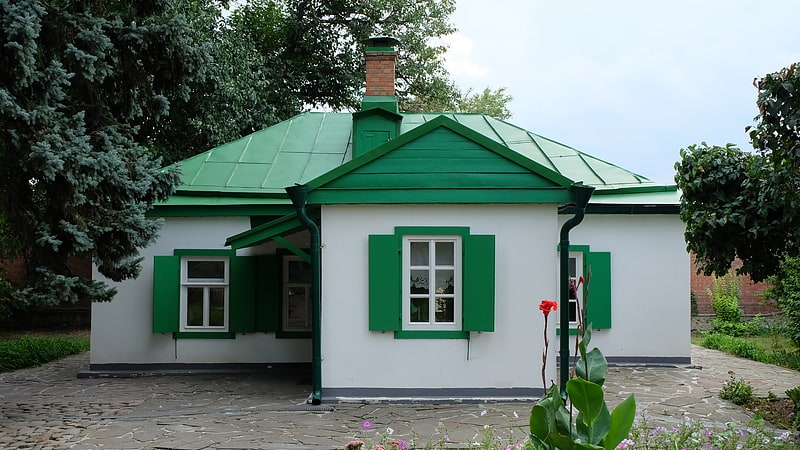
Also known as: Домик Чехова
Museum in Taganrog, Russia. The birthplace of Anton Chekhov is the place in Taganrog, Russia, where the famous writer Anton Chekhov was born. It is now a writer's house museum. The outbuilding on the territory of a property on Chekhov Street in Taganrog was built in 1859 of wattle and daub, plastered and whitened. The area taken up by the small outbuilding is 30.5 sq. meters. The house and grounds were owned by the merchant Gnutov in 1860, and by the petit bourgeois Kovalenko in 1880-1915.
Pavel Yegorovich Chekhov and his family (his wife Yevgeniya Yakovlevna and their two sons—four-year-old Alexander Chekhov and 2-year-old Nikolay Chekhov)—rented the outbuilding in December 1859. Anton Chekhov was born in this house on January 17, 1860. In March, 1861, Pavel Yegorovich Chekhov and his family moved into another apartment.
In 1910, a memorial plate was placed on the house of Chekhov thanks to the initiative of the Chekhov Circle in Taganrog, formed by the writer Yevgeny Garshin in 1905. In 1916, the Taganrog City Council supported the initiative of the Chekhov Circle and acquired the house and grounds on Chekhov Street 69 to conserve the house of Anton Chekhov. In December 1920, the house was freed from all tenants, and a renovation followed in 1921. In 1924, the first exhibition telling of the writer's youth was opened.
In 1935 Maria Chekhova and Olga Knipper came to visit the home city of Chekhov, Taganrog, to participate at the events commemorating the 75th anniversary of Anton Chekhov's birth. Within the framework of the visit, Maria Chekhova presented to the Taganrog memorial museum several Anton Chekhov or Chekhov family memorabilia from White Dacha in Yalta.
As part of the celebrations marking the 150th anniversary of Chekhov's birth, Russian President Dmitri Medvedev visited the House memorial museum on January 29, 2010.[31]
Address: Chekhova st., 69, 347900 Taganrog
Kideksha Church, Suzdal
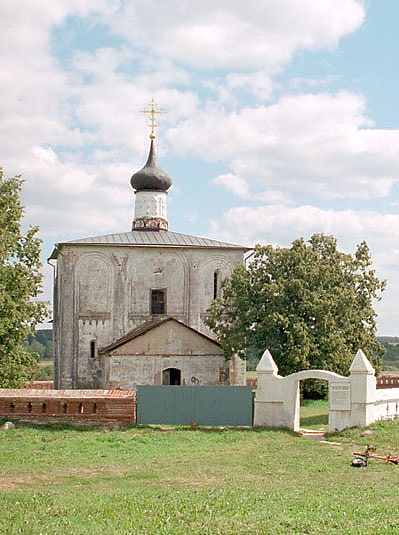
Also known as: Церковь Бориса и Глеба
Church in Kideksha, Russia. The Church of Boris and Gleb is a church built in 1152, on the orders of Prince Yuri Dolgoruky, in Kideksha on the Nerl River, "where the encampment of Saint Boris had been". It was probably part of the princely palace complex, but was only used by Dolgorukii for a few years before he left to become Grand Prince of Kiev in 1155. The village, four kilometers east of Suzdal, was an important town before it was destroyed by the Mongols and declined in stature.
The church, built in limestone probably by architects from Galicia, is a four-piered, three-apse church. It is one of the oldest in the district and one of the few churches built by Dolgorukii that is still extant. It retains fragments of frescoes dating back to the twelfth century. In the medieval period it was the site of a monastery and was then a parish church. The building has been significantly altered over the centuries. It lost its original vaulting and dome (the current roof and small dome date to the seventeenth century) and the apses are thought to be half their original height (their tops too were lost with the roof); a porch was added in the nineteenth century.
The church is a part of a UNESCO World Heritage Site "White Monuments of Vladimir and Suzdal" along with the seven other medieval monuments located in Vladimir and its surroundings (The Vladimir-Suzdal Museum-Preserve), and belongs to the monuments of the Golden Ring of Russia.
The church, along with other structures built around it in later centuries - namely the St. Stephen's Church and bell-tower) appears on a three-ruble silver commemorative coin struck by the St. Petersburg Mint in 2002.[32]
Address: Ulitsa Tsentral'naya, 63, 601293 Kideksha
Chekhov Shop, Taganrog
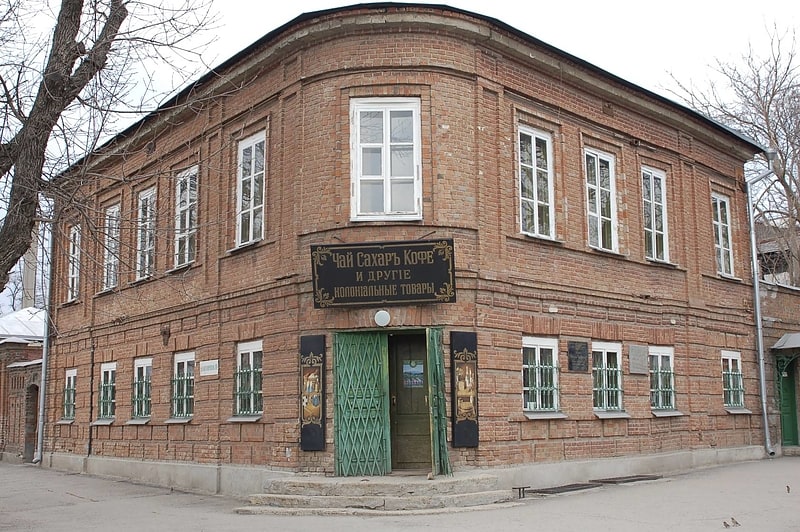
Also known as: Лавка Чеховых
Museum in Taganrog, Russia. The Chekhov Shop is a museum in Taganrog, Russia. This is a two-storey house where the famous Russian writer Anton Chekhov stayed with his family from 1869 to 1874.
The building was built in late 1840s and is located on the crossing of Alexandrovskaya (formerly Monastirskaya Street) and Gogol Street (formerly Yarmarochniy Pereulok). The Chekhov family rented this building from the merchant Ivan Moiseev. The family moved into this building due to commercial interests of Anton Chekhov’s father. The shop’s entry featured a sign "Tea, sugar, coffee, and other colonial goods".
When Anton’s father was away on business, he had to replace him serving as shop assistant and keeping the accounting records. It is on the first floor of this house that the future world-famous playwright wrote his first stories and staged amateur theatricals with other Chekhov family children or with gymnasium fellow students.
November 3, 1977 museum "The Chekhov Shop" was open offering visitors objects and documents related to Chekhov youth years and life of the Chekhov family.[33]
Address: Sverdlova ul., d. 100, 347900 Taganrog
Ekaterinburg Museum of Fine Arts, Yekaterinburg
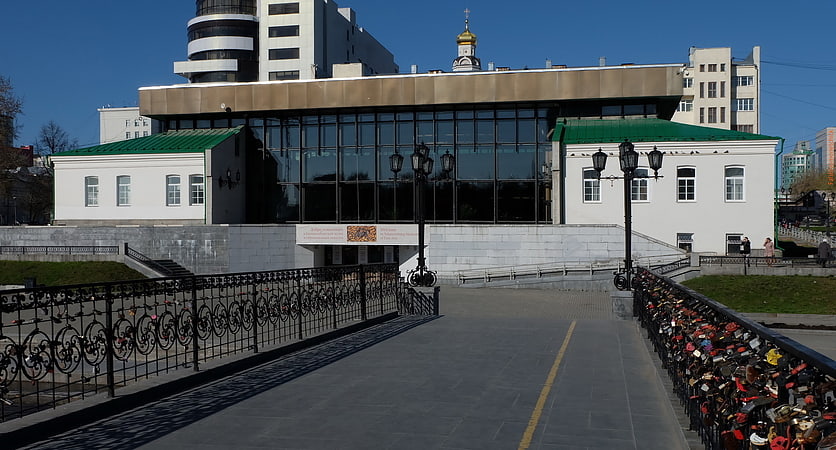
Museum in Yekaterinburg, Russia. The Yekaterinburg Museum of Fine Arts, established in 1986, is the largest art museum of the Urals region of Russia. It is based in Voevodina Street on the banks of the Iset River in the city of Yekaterinburg.
At the heart of the museum building is one of the oldest buildings in Yekaterinburg, a hospital built in 1730 for the Yekaterinburg Ironworks. The building was modified several times during the 19th century. In the 1970s, most of the buildings of the former ironworks were demolished and the Historical Square laid out in their place. At the end of the 1970s, the idea of converting the remainder into a museum space was suggested. The project was completed in 1986.[34]
Address: Voyevodina St., 5, 620014 Yekaterinburg
Pskov Krom, Pskov

Also known as: Псковский Кром
Ancient riverside citadel with towers. The Pskov Krom, also known as the Pskov Kremlin, is an ancient citadel in Pskov, Russia. In the central part of the city, the Krom is located at the junction of the Velikaya and Pskova rivers. The citadel is of medieval origin, with the surrounding walls constructed starting in the late 15th century.
The Krom was the administrative and spiritual centre of the Pskov Republic in the 15th century.
In 2010, two of the towers of the Krom (the Vlasyevskaya, which dates to the 15th or 16th century, and the Rybnitskaya, which dates to 13th or 14th) were damaged in a fire.
It's a Russian nominated candidate site on the UNESCO World Heritage Tentative List under 'Great Pskov' nomination.[35]
Church of All Saints, Yekaterinburg

Also known as: Храм на Крови
Church in Yekaterinburg, Russia. The Church on Blood in Honour of All Saints Resplendent in the Russian Land is a Russian Orthodox church in Yekaterinburg. Being built on the site of the Ipatiev House where Nicholas II, the last Emperor of Russia, and his family, along with members of the household, were executed by the Bolsheviks during the Russian Civil War, the church commemorates the Romanov sainthood.[36]
Address: ul. Tolmacheva, 34, 620075 Yekaterinburg
Rastorguyev-Kharitonov Palace, Yekaterinburg
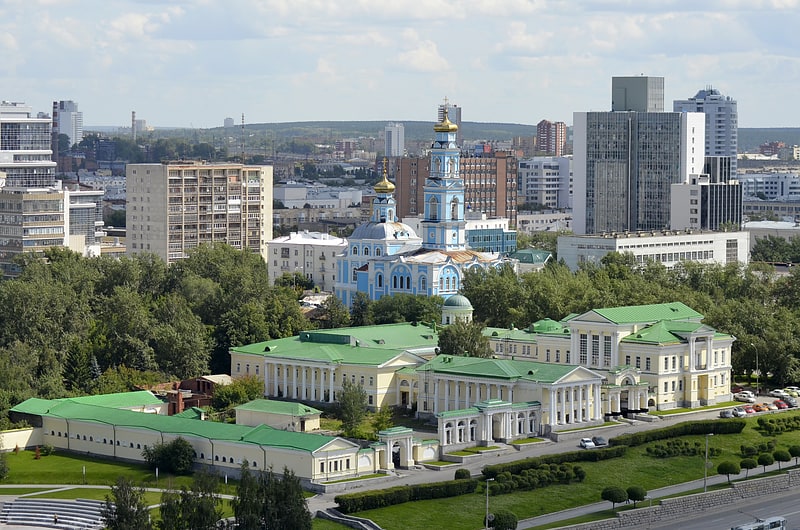
Also known as: Усадьба Расторгуевых — Харитоновых
Manor house in Yekaterinburg, Russia. The Rastorguyev–Kharitonov Palace is arguably the grandest palatial residence in the Urals. This Neoclassical townhouse was commissioned in 1794 by Lev Rastorguyev, an Old Believer merchant and landowner. The main house was built on the so-called Annunciation Hill in Yekaterinburg. The nearby Annunciation Church was built at the same time.
The palace takes its present name from Pyotr Kharitonov, Rastorguyev's son-in-law. He inherited the property in 1824 and employed architect Mikhail Pavlovich Malakhov to connect the buildings with a series of covered passageways. An English park on the grounds was also commissioned by Kharitonov. His harsh treatment of the serfs gave rise to a bevy of legends about a network of underground chambers and passages where his peasants were tortured.
In 1837 Kharitonov was officially censured for his cruelty, put on trial and condemned to life imprisonment in Kexholm Fortress. The palace fell into disuse.
It was repaired in Soviet Time in the late 1930s to house a local Pioneers Palace. After USSR and pioneers system fall, it continued to function as children's art school.
Pyotr Latyshev, the Presidential Envoy to Urals Federal District, planned to take over the palace in 2000. Corresponding Presidential Decree was issued. But protests of art school children's parents sparkled, one of them—politician Anton Bakov—appealed to Supreme Court and later Constitutional Court where he won. Local political tensions also took place, they were later described in a 2014 documentary novel "Eburg" by writer Alexei Ivanov.[37]
Address: Ulitsa Karla Libknekhta, 44, 620075 Yekaterinburg
Minin and Pozharsky Square, Nizhny Novgorod
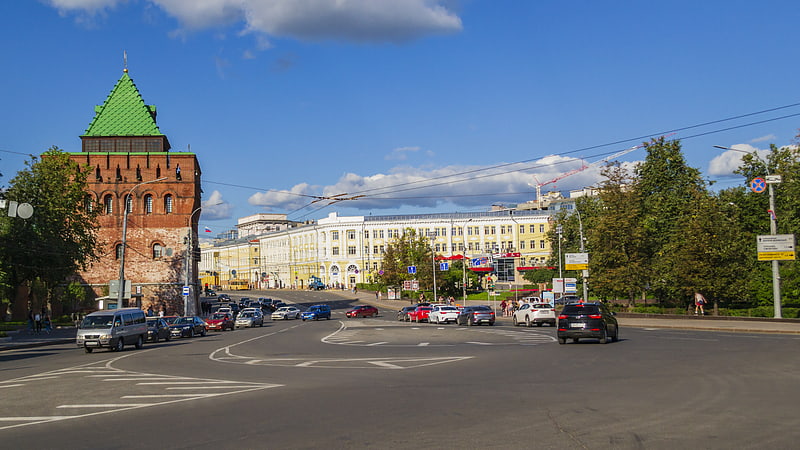
Also known as: Площадь Минина и Пожарского
The Minin and Pozharsky Square is the main square of Nizhny Novgorod. It is a social and cultural center of the city, the venue of the most important celebrations. It is located in the historical centre of the old town from the southeast side of the Kremlin.
The square connects the central streets of the city: Bolshaya Pokrovskaya, Varvarskaya, Ulyanov, Minin, Upper Volga embankment and Zelensky Descent. There are many architectural monuments, the Minin University, Lobachevsky University and the Medical University; monuments to Minin, Chkalov; Exhibition Complex, as well as the first city fountain.
The square is the roadway. Movement on it overlaps only on holidays and at the time of other events.[38]
Nativity church, Nizhny Novgorod
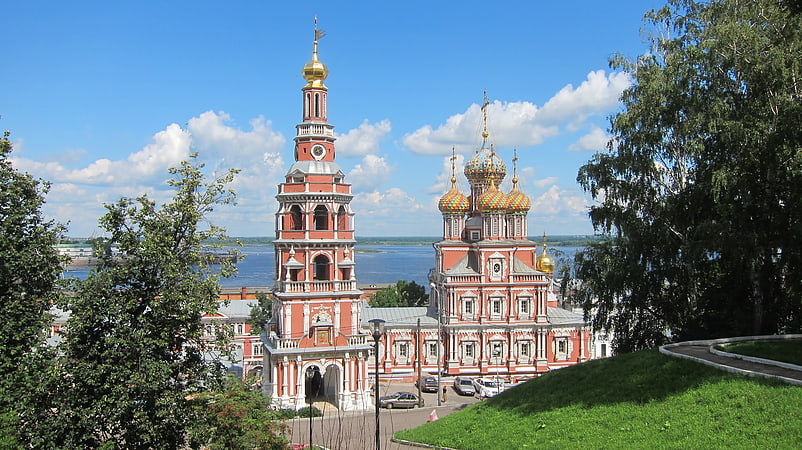
Also known as: Рождественская церковь
Russian orthodox church in Nizhny Novgorod, Russia. Church of the Nativity of the Blessed Virgin Mary, better known as Nativity or Stroganov is a Russian Orthodox church, located at the Rozhdestvenskaya Street in Nizhny Novgorod. It was built in 1696-1719 on the means of the merchant Grigory Stroganov. It is one of the best examples of Stroganov style, it has the status of a monument of architecture of federal significance.[39]
Address: Rozhdestvenskaya St, 34, 603001 Nizhnij Novgorod
Church of the Exaltation of the Holy Cross, Kazan

Also known as: Храм Воздвижения Святого Креста
Catholic church in Kazan, Russia. The Church of the Exaltation of the Holy Cross is a Roman Catholic church in the city of Kazan, Tatarstan, Russia, under the Diocese of Saratov.
The first modern Catholics came to Kazan in the eighteenth century and were mainly of German origin. In 1835, the first parish was founded by Polish priests, and its parishioners gathered in private homes or temporary structures. The Catholic population, mostly of Polish origin, increased steadily, and the city of Kazan ultimately granted permission to build the church in 1855. Permission to build the church came with the conditions that the church would not stand out from the surrounding buildings and would not display a strong traditional Roman Catholic architectural character.
Kazan's Catholic parish dispersed during the era of communism and was reconvened in 1995, but the church was not returned to the Catholic community. Officials of the city instead authorized the use of a small chapel located in one of the city's cemeteries. Once restored, the chapel was consecrated by Bishop Pickel in 1998. A few years later, due to the removal of the wind tunnel from the old church, city authorities decided to allocate land in the center of Kazan to the Catholic community. Construction of the new church began in 2005 and took three years to complete.
On 29 August 2008, the new church was consecrated during a ceremony led by the Dean of the College of Cardinals, Angelo Sodano, in the presence of the Bishop Clemens Pickel, the Apostolic Nuncio Antonio Mennini, and other leaders.[40]
Address: 73 улица Островского, Kazan
The Motherland Calls, Volgograd
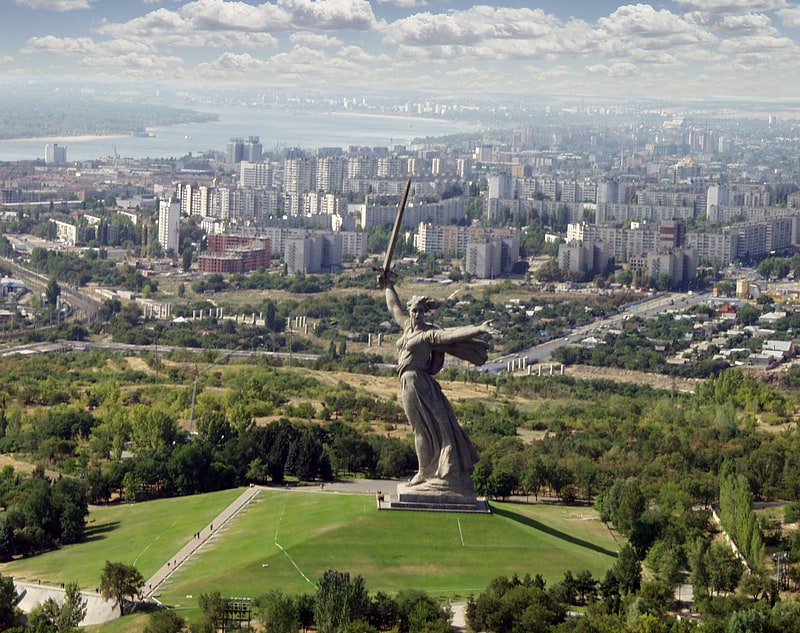
Also known as: Родина-мать
Enormous Battle of Stalingrad memorial. The Motherland Calls is the compositional centre of the monument-ensemble "Heroes of the Battle of Stalingrad" on Mamayev Kurgan in Volgograd, Russia. The statue is designed in the Soviet style of socialist realism. It was designed by sculptor Yevgeny Vuchetich and structural engineer Nikolai Nikitin, and declared the tallest statue in the world in 1967. At 85 m, it is the tallest statue in Europe, the tallest outside of Asia and the tallest statue of a woman in the world.[41]
Address: Мамаев Курган, Volgograd
The Rich Well, Rostov-on-Don
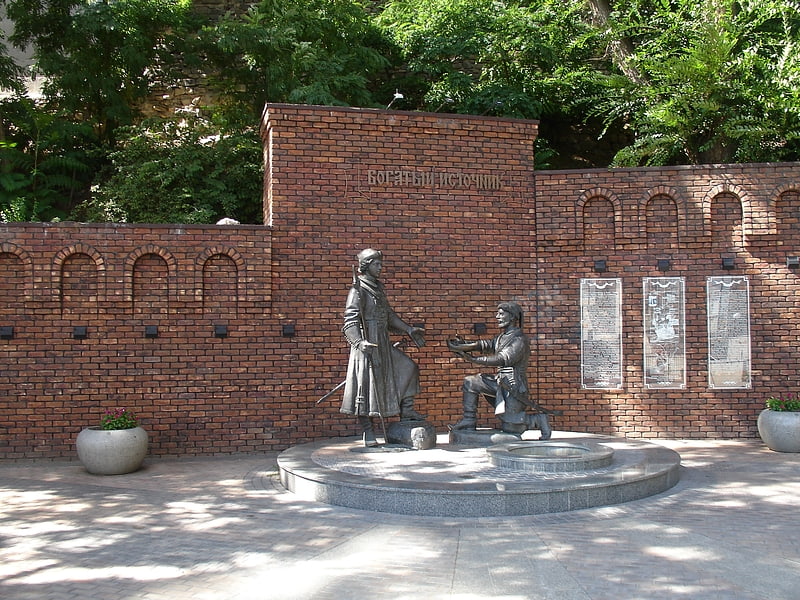
Bogatuanovsky spring — a monument of history and nature in the city of Rostov-on-Don on the Bogatuanovsky descent, situated between Sedova Street and Beregovaya Street.[42]
Southern Federal University's botanical garden, Rostov-on-Don

Botanical garden in Rostov-on-Don, Russia. Southern Federal University's botanical garden is located in the North-Western part in Rostov-on-Don, in the Temernik river valley. It's the first botanical garden in the vast territory of the treeless zone in the South of Russia. There is a mineral spring called St.Seraphim of Sarov on the territory of the garden, which is presented by the Directorate of the garden as an Orthodox shrine.[43]
Central Market, Rostov-on-Don
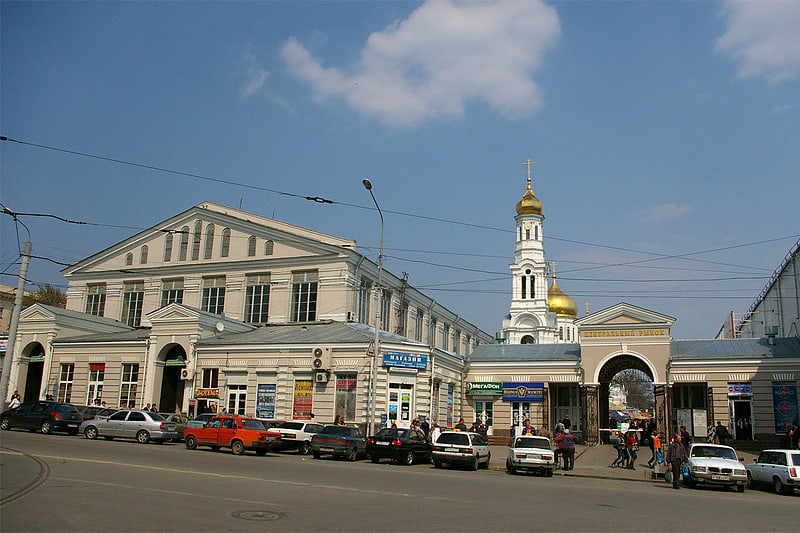
The Central Market (Russian: Центральный рынок; also known as the Old Bazaar is a city market and trade enterprise in Rostov-on-Don. It is unofficially known as «Starbaz» (Russian: «Старбаз». Its official name during the Soviet period was the "Andreyevsky District Market". It is currently officially known as "CJSC «Central market» of Rostov-on-Don".[44]
Address: Буденновский просп., 12, 344002 Ростов-на-Дону
Trinity Cathedral in Pskov, Pskov
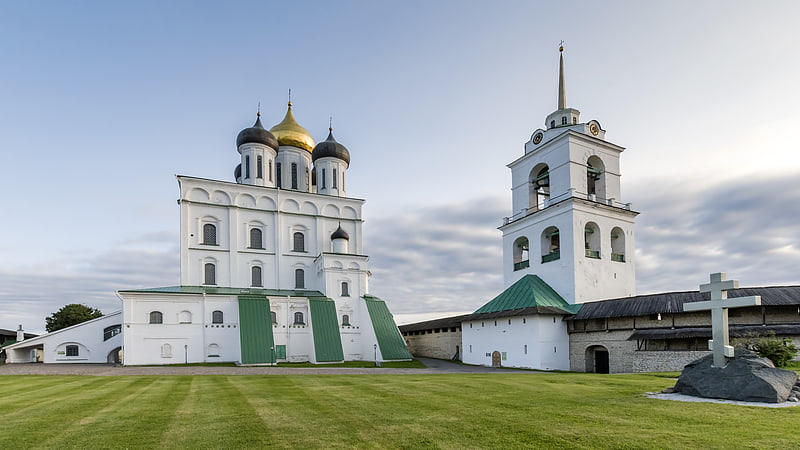
Also known as: Троицкий собор
Church in Pskov, Russia. The Trinity Cathedral is located in the Pskov Krom or Kremlin on the east bank of the Velikaya River. It has, since 1589, been the mother church of the Pskov Eparchy.
The first wooden Trinity Cathedral (the Russian term sobor, translated as "cathedral" can mean any major church irrespective of it being a cathedral church of a bishop) was built in the tenth century, allegedly under the patronage of Princess Olga, but this seems unlikely as Olga's conversion was personal, and the conversion of the Rus Land did not occur until 988, almost two decades after her death. Thus, it seems likely the first church dates to the time of Christianization or shortly thereafter. This church was replaced by a stone church in 1138, allegedly at the behest of Prince Vsevolod Mstislavich, who died the previous year. The cathedral was destroyed and rebuilt several times over the centuries; for example, the Novgorodian First Chronicle mentions that in 1365, Archbishop Aleksei of Novgorod (r. 1359-1388) blessed the reconstruction of a stone church on the foundations of the original Trinity church; it was completed in 1367 under the direction of Master Kirill (who appears to have died in the plague of 1390). This church was heavily damaged in a fire in 1609 and the interior was renovated aftwards. The current building was built beginning in 1691 and consecrated in 1699.
In the Soviet period, the cathedral was part of the schismatic Living Church movement in the 1920s before its closure in the 1930s, at which time it was turned into a museum. It was reopened as a church during the Nazi occupation. It remained open after the war.
The cathedral is 256 feet tall and contains the tombs of saint princes Vsevolod Mstislavich (also known as Gavriil - died in 1138) and Dovmont (died in 1299).
The current bishop of Pskov, as of February 1993, is Archbishop Evsevii (Nikolai Afanas'evich Savvin).[45]
Address: Kremlin, 2/1, 180000 Pskov
Mirozhsky Monastery, Pskov
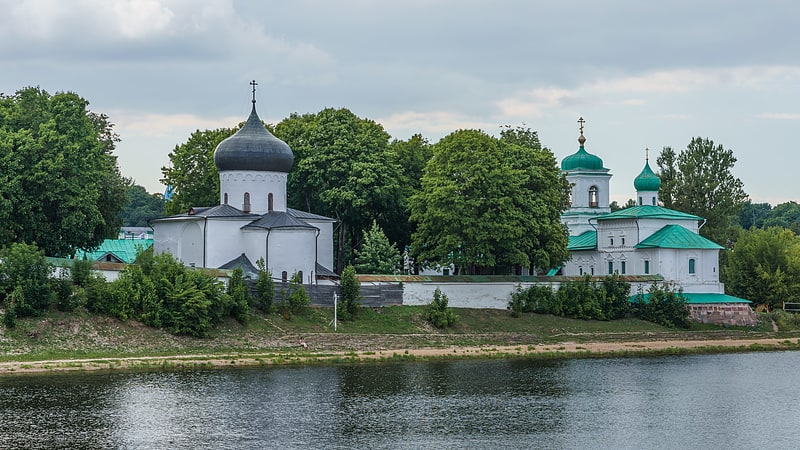
Also known as: Мирожский монастырь
Monastery in Pskov, Russia. Mirozhsky Monastery is a 12th-century Russian Orthodox monastery complex in Pskov, Russia, famous for its frescoes, located in the Christ's Transfiguration Cathedral. The name of the monastery is derived from the name of the Mirozha River, since the monastery is located at the place where the Mirozha joins the Velikaya River, on the left bank of the Velikaya. The catholicon of the monastery is one of the two pre-Mongol buildings which survived in Pskov, and contains the frescoes of the 12th century. The monastery, together with the Transfiguration Cathedral, is part of the Churches of the Pskov School of Architecture, which became an World Heritage Site in 2019.[46]
Address: Красноармейская наб., Pskov
Gornaya Karusel, Sochi National Park
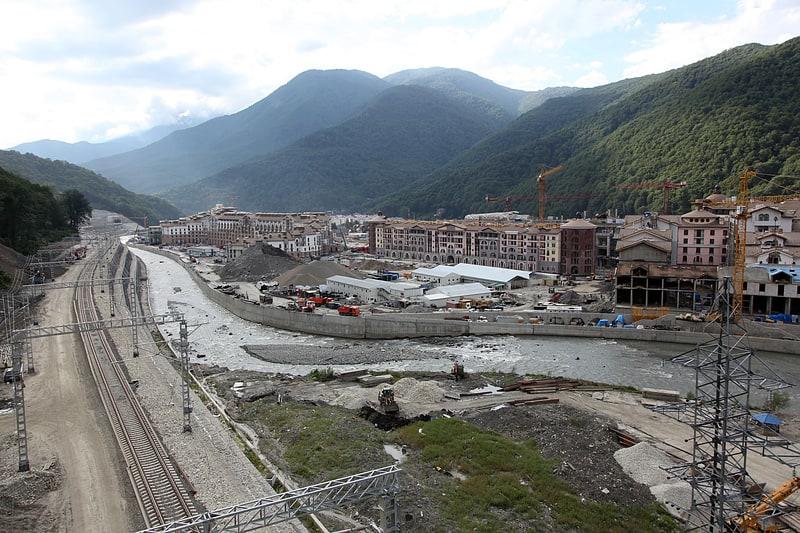
Also known as: Горная карусель
Ski area. Gornaya Karusel is a sports and tourism area on the Northern slopes of Mount Aibga in Estosadok, Sochi.[47]
Mamayev Kurgan, Volgograd
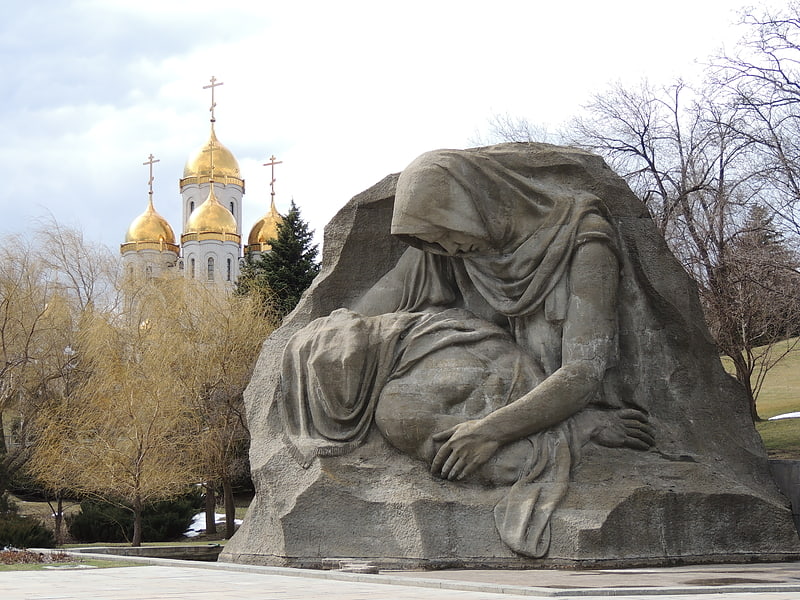
Also known as: Мамаев курган
Hill with a complex of memorials. Mamayev Kurgan is a dominant height overlooking the city of Volgograd in Southern Russia. The name in Russian means "tumulus of Mamai". The formation is dominated by a memorial complex commemorating the Battle of Stalingrad. The battle, a hard-fought Soviet victory over Axis forces on the Eastern Front of World War II, turned into one of the bloodiest battles in human history. At the time of its installation in 1967 the statue, named The Motherland Calls, formed the largest free-standing sculpture in the world; today it is the tallest sculpture of a woman in the world.[48]
Address: Prospekt Imeni V.i. Lenina, 400005 Volgograd
Ascension Church, Yaroslavl
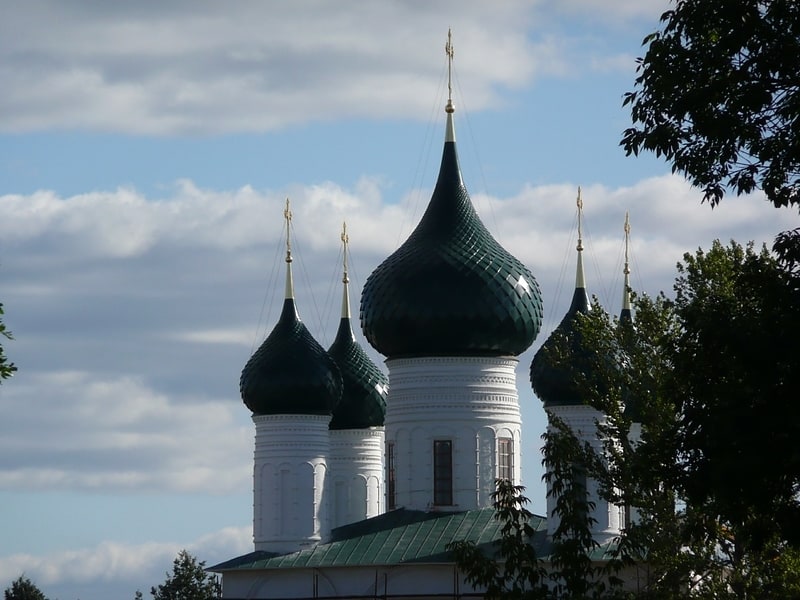
Also known as: Вознесенско-Сретенский приход
The Church of the Ascension of Christ is a four-piered penticupolar Orthodox church erected in Kondakovo, a western suburb of Yaroslavl between 1677 and 1682.
The first church on the site was commissioned in 1584 by Basil Kondaki, a wealthy Greek merchant, in order to prevent the planned construction of a Lutheran church in Kondakovo. A smaller parish church is dedicated to the Presentation of Jesus at the Temple. This late Baroque building incorporates the 17th-century refectory, a survival from an earlier church. A belfry dating from 1745 was demolished in the 20th century.
The parish churches sustained damage in the Yaroslavl Revolt of 1918 and were later adapted for use by a nearby car barn. The larger church, with all the domes taken down, was used as a depot. Aleksey Soplyakov's frescoes from 1736 have all but disappeared. It was not until the late 2000s that the buildings were returned to the Russian Orthodox Church and restoration work began.[49]
Monument of Glory, Samara
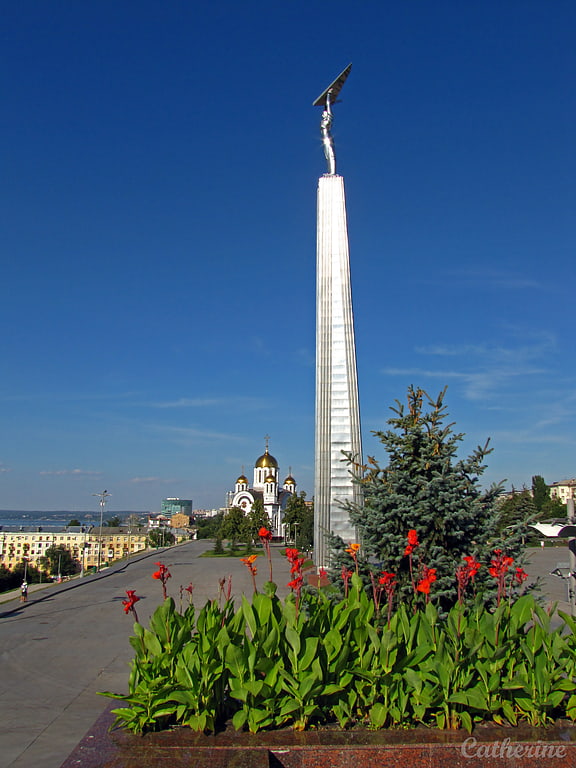
The Monument of Glory is the focal point of Slavy Square in Samara, Russia, overlooking the Volga river to the north-west. It is dedicated to the Kuybyshev workers of aircraft industry, who were working hard during and following the Great Patriotic War. The monument is one of the most prominent symbols of Samara. Moscow sculptors Pavel Bondarenko, Oleg Kiryuhin and architect A. Samsonov created a design of the thirteen-meter-tall figure, made from high alloy steel with wings raised over his head and forty-meter pedestal. The pedestal symbolizes ray of light rising to the sky.
The monument was erected between 1968 and 1971 for donations of Kuybyshev workers and other staff members of production plants. Every worker could donate only one rouble. Kuybyshev mayor's office chose a place for the monument in the city centre in the Leninsky district. The opening ceremony took place on 5 November 1971.[50]